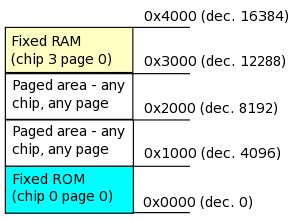Memory
Overview
The Sinclair Spectrum unfortunately doesn't have a formal sideways memory scheme. Instead, we just have the ability to page in external memory into the lower 16K of the Z80's address space, then manage this ourselves. Memory management is carried out by the CPLD, which looks after which pages are mapped where, and when to page in our memory map into the lower 16K address space.
The Spectranet memory is arranged in 4K pages, with up to 4 chips (chips 0 to 3), each chip a maximum of 1Mbyte in size (the actual hardware uses a 128K flash ROM, a 128K static RAM and the W5100's 32K). The flash ROM is chip 0, the W5100 is chip 1, chip 2 is unused at present and chip 3 is the static RAM. Two pages are permanently mapped into the lowest 4K (flash ROM) and highest 4K (static RAM). This is to guarantee to software that certain memory will always be in the same place; page 0 of flash is used to contain initialization routines, the socket library and interrupt handlers. Page 0 of the static RAM is to hold general purpose workspace, system variables, and the jump table.
The middle 8K of this area is the paged area. Any page of any chip can be paged into page area A (0x1000 to 0x1FFF) or page area B (0x2000 to 0x2FFF).
Selecting pages for the paged area
Three registers are provided for selecting pages - page register A, which contains the page for 0x1000 to 0x1FFF, and page register B for 0x2000 to 0x2FFF. The third register is the chip select register. Bits 0 and 1 select the chip in page area A, and bits 2 and 3 select the chip for page area B.
The following I/O ports are used (important - these may change during prototyping):
- Port 0xE9 - Memory page for area A (8 bits)
- Port 0xEB - Memory page for area B (8 bits)
- Port 0xED - Chip select for both areas (4 bits)
The complete 8 bits of the port address is decoded, so only OUT instructions to these specific ports will work (unlike older peripherals, which tend to only decode at most 3 bits of a port address). The paging registers are write-only; the currently selected page should be stored in the system variables area.
A code example to select page 3 of the static RAM into page area A:
LD A, (SYS_CHIPSELECT) ; get the currently selected chips OR 3 ; set lower 2 bits OUT (0xED), A ; set chip select register LD (SYS_CHIPSELECT), A ; store new value of chip select register LD A, 3 ; page 3 OUT (0xE9), A ; set page register for area A LD (SYS_PAGEAREA_A), A ; save register value in RAM
TODO: A routine will be provided to allow for "longcalls" (page in a specific page, and call it, and restore on return).
ROM Memory Map
Most of the flash ROM is available for developers to use for their own purposes (see Writing Spectranet ROMs for more information). There are 32 4k pages (pages 0x00 to 0x1F) available. The following pages are reserved for the Spectranet itself:
- Page 0x00 - Permanently mapped to 0x0000-0x0FFF. This contains the socket library and utility function calls.
- Page 0x01 - Spectranet data.
- Page 0x02 - Spectranet utility programs - configuration utility and DHCP client.
- Page 0x03 - Reserved for future use.
- Last 256 bytes of page 0x1F - Storage for Spectranet configuration.
RAM memory map
Most of the static RAM is also available for developers, however, some is reserved:
- Page 0x00 - Permanently mapped to 0x3000-0x3FFF. Contains temporary workspace, buffers, and system variables. Some of this is available to developers; see below.
Pages 0x01 and 0x02 are used to store a copy of the Spectrum's frame buffer when an NMI or similar event is triggered. Pages 0x1C-0x1F are used by the configuration utility when rewriting the last erase sector of the flash rom, while updating the configuration.
